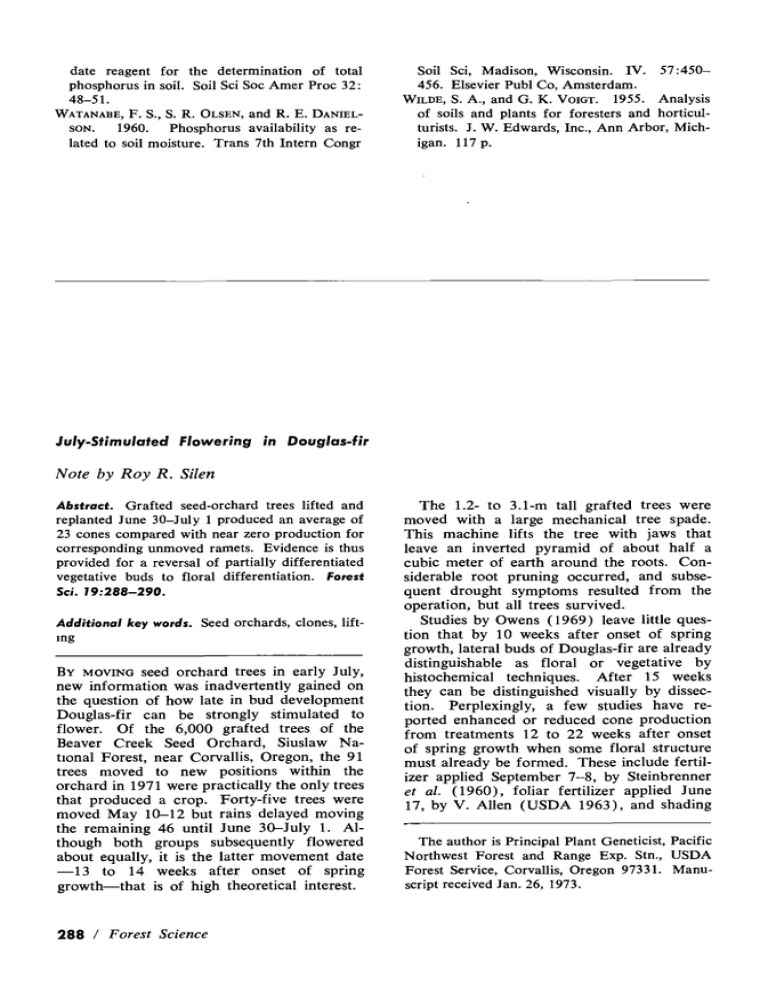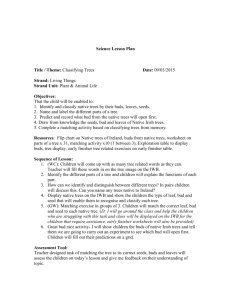Soil Sci, Madison, Wisconsin. IV. ... date reagent for the determination ... phosphorus in soil. Soil Sci Soc Amer Proc ...
advertisement

date reagent for the determination of total phosphorus in soil. Soil Sci Soc Amer Proc 32: 48-51. WATANABE, F. S., S. R. OLSEN, and R. E. DANIEL­ SON. 1960. Phosphorus availability as re­ lated to soil moisture. Trans 7th Intern Congr Soil Sci, Madison, Wisconsin. IV. 57:450­ 456. Elsevier Pub! Co, Amsterdam. WILDE, S. A., and G. K. VOIGT. 1955. Analysis of soils and plants for foresters and horticul­ turists. J. W. Edwards, Inc., Ann Arbor, Mich­ igan. 117 p. July-Stimulated Flowering in Douglas-fir Note by Roy R. Silen Abstract. Grafted seed-orchard trees lifted and replanted June 30-July 1 produced an average of 23 cones compared with near zero production for corresponding unmoved ramets. Evidence is thus provided for a reversal of partially differentiated vegetative buds to floral differentiation. forest Sci. 19:288-290. Additional key words. Seed orchards, clones, lift­ mg BY MOVING seed orchard trees in early July, new information was inadvertently gained on the question of how late in bud development Douglas-fir can be strongly stimulated to flower. Of the 6,000 grafted trees of the Beaver Creek Seed Orchard, Siuslaw Na­ tiOnal Forest, near Corvallis, Oregon, the 91 trees moved to new positions within the orchard in 1971 were practically the only trees that produced a crop. Forty-five trees were moved May 10-12 but rains delayed moving the remaining 46 until June 30--July 1. Al­ though both groups subsequently flowered about equally, it is the latter movement date -13 to 14 weeks after onset of spring growth-that is of high theoretical interest. 288 I Forest Science The 1.2- to 3.1-m tall grafted trees were moved with a large mechanical tree spade. This machine lifts the tree with jaws that leave an inverted pyramid of about half a cubic meter of earth around the roots. Con­ siderable root pruning occurred, and subse­ quent drought symptoms resulted from the operation, but all trees survived. Studies by Owens ( 1969) leave little ques­ tion that by 10 weeks after onset of spring growth, lateral buds of Douglas-fir are already distinguishable as floral or vegetative by histochemical techniques. After 15 weeks they can be distinguished visually by dissec­ tion. Perplexingly, a few studies have re­ ported enhanced or reduced cone production from treatments 12 to 22 weeks after onset of spring growth when some floral structure must already be formed. These include fertil­ izer applied September 7-8, by Steinbrenner et al. (1960), foliar fertilizer applied June 17, by V. Allen (USDA 1963), and shading The author is Principal Plant Geneticist, Pacific Northwest Forest and Range Exp. Stn., USDA Forest Service, Corvallis, Oregon 97331. Manu­ script received Jan. 26, 1973. and removal of seed-cone buds in July­ August, by Silen (1968). Since 1968 I have also conducted several field studies employ­ mg shade, foliar fertilizer, girdling, cold, heat, moisture stress, and floral bud or leaf re­ moval aimed at clarifying floral responses in this period. Results have been inconclusive, often conflicting and are unpublished. In contrast, this chance field observation adds a particularly convincing case of such a late floral response. Observations. The odd flowering pattern first was noticed by Don Oliver, Seed Orchardist, Siuslaw National Forest. On May 25, 1972, when vegetative shoots were elongating, we made observations of the moved trees together with a like number of unmoved trees of the same clones. Records were made of total bud count, seed cone count, presence of pollen cones, elongation of longest terminal shoot of the top whorl, tree height, graft height, and 1971 terminal growth. Data were tabulated according to movement date, clone, and seed orchard block. Statistical analyses were per­ formed where appropriate. The nearly total absence of cones in the control group elim­ Inated the need for a statistical analysis of cone number data. A detailed examination was made of dis­ sected buds from six clones collected on July 1, 1972, to determine developmental stage. Samples were also sent to Dr. J. N. Owens, University of Victoria (B.C.). Both of us found that some differentiation of primordial leaves or bracts was taking place at the base of the apical dome. Each of us found at least one bud showing megasporangiate development. Apical domes were still un­ differentiated. Data. Following the heavy 1971 cone crop, Douglas-fir trees in the Corvallis country­ side were generally barren of a crop in 1972; and among the 6,000 grafted trees of the Beaver Creek Seed Orchard, less than a dozen bore cones. Of the 91 seed orchard trees carefully inspected as controls, only one bore a few seed cones for a 1972 crop. In con­ trast, 54 of 91 moved trees bore an average of 23 seed cones in addition to numerous pollen cones for a 1972 crop. An addi­ tional five trees bore only pollen cones. Thus, about 65 percent of the moved trees displayed an obviously significant floral response to the treatment. The July-moved trees produced a somewhat stronger floral response than the May-moved trees. Of the 46 moved on June 30-July 1, the 31 that bore cones (67 percent) had an average of 22.6 seed cones. Of the 45 trees moved May 10-12, the 23 that bore seed cones (51 percent) averaged 23.7 seed cones The larger percentage of trees bearing cones in July, although not statistically significant, could possibly be due to the slightly larger grafts characteristic of the seed orchard blocks involved. Frequency distributions were very similar between the two dates. As expected, moved trees grew less m height (32.3 em) in 1971 than unmoved trees (50.4 em). There was no difference in growth between May- and July-moved groups Counts of active or latent buds showed no consistent difference between moved and unmoved trees. Discussion. Profuse flowering of moved garden trees and shrubs is commonly ob­ served. Also, the essentially all-or-nothmg response reported here is strikingly similar to results following drought treatment of potted Douglas-fir grafted plants by Ebell ( 1967). Floral responses from some en­ vironmental treatments of Douglas-fir applied in the period from bud burst through shoot elongation have been reported ( Stoate et al 1961, Silen 1968, Ebell 1971). What IS rare, and has important theoretical aspects, IS so strong a floral response to a treatment when bud development is so far advanced. Previous studies of floral responses resultmg from various treatments during the period of bud differentiation (July-September) have been cautiously viewed as possible artifacts by the authors (Steinbrenner et al. 1960, Silen 1968) . The theoretical meaning of these re­ ports must now be reconsidered. Douglas-fir cone crops appear to vary pn­ marily because of yearly differences in num­ ber of buds that stop developing, rather than from number initiated (Silen 1968, Owens 1969, Ebell 1971). As a consequence, a normal assumption was that a tree starts m spring with maximum floral bud potential which can be successively reduced by change­ over during development to active or dor­ mant vegetative bud types. This unidirec­ tional assumption was supported by observa­ tions that potentially good cone crops begm with a profusion of buds on the expandmg shoot (Silen 1968). Owens' (1969) evi­ dence, that metabolic pathways probably begin to diverge in early spring into floral and vegetative bud development, added further support. Likewise, response to stimulatory volume 19, number 4, 1973 I 289 treatments to the tree (Ebell 1971, Silen 1968) suggested that pre-existing floral buds were preserved, rather than new floral de­ velopment stimulated. Conversely, inhibitory treatments such as shading caused increased abortion or latency of buds. Later ( unpub­ hshed) field studies in which I attempted to stimulate new floral bud development were mconclusive. Hence, there has been no pre­ vious firm evidence for suggesting that any new floral initiation normally occurs after early spring. Indeed, a unidirectional hy­ pothesis (Silen 1968) based upon abortion or latency mechanisms seemed adequate to explain the tree's habits in balancing floral With vegetative needs over the 17 months of cone crop development. The equally strong stimulus to floral bud development, provided by moving the trees at the seed orchard in either May or early July, now suggests that responses sometimes go strongly in the other direction as well. That IS, a developmental changeover, possibly from newly-activated genes, may occur from vege­ tative to floral at any month of the bud de­ velopment period. It seems more tenable, con­ sidering how often a barren year has followed a bumper crop, that most of the 6,000 trees were physiologically and anatomically well along toward commitment by differentiation to vegetative buds by July 1, and that a strong changeover to floral bud develop­ ment occurred in the moved trees. The alter­ native, an assumption that buds on about two-thirds of the 6,000 trees were proceed­ mg on floral pathways that changed to vege­ tative pathways in the last few weeks before 290 I Forest Science differentiation in all but the moved trees, does not seem as tenable. This and the papers previously cited suggest the possibility that such late changeover of bud type occurs if the stimulus is sufficiently strong. The practical aspect is to suggest tree lifting as a new tool for floral studies on whole trees. Literature Cited EBELL, L. F. 1967. Cone production induced by drought in potted Douglas-fir. Can Dep For, Bi-Mon Res Notes 23(4) :26-27. 1971. Girdling: its effect on carbohy­ drate status and on reproductive bud and cone development of Douglas-fir. Can J Bot 49 453-466. OWENS, JOHN N. 1969. The relative importance of initiation and early development on cone production in Douglas-fir. Can J Bot 47 1039-1049. SILEN, RoY R. 1968. How early can Douglas­ fir cone crops be predicted? In Western Re­ forestation. West Forest Conserv Assoc Conf Proc 1967:12-18. STEINBRENNER, E. C., J. W. DUFFIELD, and R. K CAMPBELL. 1960. Increased cone production of young Douglas-fir following nitrogen and phosphorus fertilization. J Forest 58:105-110 STOATE, T. N., I. MAHOOD, and E. C. CROSSIN. 1961. Cone production in Douglas-fir (Pseudotsuga menziesii). Empire Forest Rev 40(2): 104-110. USDA FoREST SERVICE. 1963. Dennie Ahl Seed Orchard. Olympic Nat! Forest, Reg 6. 19 p.






